|
Visitors to Stow-on-the-Wold call in at the Tourist Information Centre for a chat,
buy postcards, maps and walking books. Many visitors ask about the town and its lovely
old square and want to know about its history and what helped to create such interesting
architecture.
In fact, so many people asked similar questions, we decided to produce a tri-fold
leaflet containing old photographs that tried to tell Stow’s story in a simple
way. It was nice to be able to give something out to visitors and I am sure it was
nice for them to take away a small reminder of their visit.
Stow-on-the-Wold is
an ancient Cotswold Wool
Town situated beside The Fosse Way, a Roman road that runs
from Exeter to Lincoln in an almost straight line. It is set on a rounded hill at
a height of about 800 feet above sea level. This elevated position, and the effects
of the wind and rain have encouraged the creation of the enclosed town square. Keeping
the winter winds out of the town centre does, to certain extent, seem to work.
Iron Age people were the first to settle on the hill but there is evidence of earlier
settlements in this part of the Cotswolds. Stone Age and Bronze Age burial mounds
are common throughout the area.
There is a strong tradition that in Saxon times a missionary named Edward lived
as a hermit at the well on the south side of the town. This helped to establish the
first name of the town as St. Edward's Stowe or Holy Place. The word 'wold' as in
Cotswold means hills, so Stow-on-the-Wold simply means Holy Place on the Hill.
The houses of Stow were built with the mellow Cotswold limestone from local quarries.
Some have massive internal oak beams from the days when Gloucestershire was covered
in forest. Many of the houses were built in the 16th century and those built later
have blended in to become part of the character of this beautiful town, a place that
has evolved over some 500 years.
One of the oldest houses, the 'Crooked House' on
the west side of the Square, was built about 1450. The Kings Arms is a good example
of a coaching inn where the main entrance was through the arch leading to the stables.
Charles I stayed here about the time of the Battle of Naseby in 1645. On Digbeth
Street stands the Royalist Hotel, said to be the oldest inn in England. An inn has
stood on this site since 947AD. The stocks on the green are the latest in a long
line dating back to the 15th century.
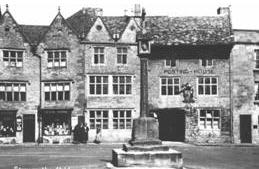 |
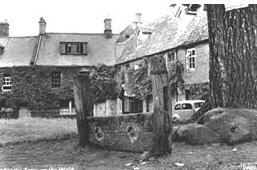 |
| The Kings Arms and Market Cross |
The Stocks |
In March 1646, the last important battle of the Civil
War ended in the Square. The
Parliamentary army under the command of Colonel Morgan overwhelmed Sir Jacob Astley's
Royalist army. 1000 prisoners were held in the parish Church while the wounded were
laid in Digbeth Street. It is said the street ran with blood. To remember those who
fought and died at this time, a memorial stone was placed in St. Edward's churchyard
in 1992.
Stow was, until recent times, supplied with water from springs below the town. For
centuries, women and children had carried water with yoke and bucket from the spring
on Well Lane. Water carts plied between Well Lane and the town where the water was
sold to the townsfolk at the price of a farthing a bucket. Several systems had been
tried to force water up the hill including windmills, horse-mills and water wheels
but all had failed. In 1871, Joseph Chamberlayne-Chamberlayne, lord of the manor,
donated £2000 to the town for a deep well to be bored and this was a success.
Mains water was laid on in 1937. Sewage disposal used numerous cavities in the rock,
known locally as swillies, as natural soakaways under and around the houses until
mains drainage was installed in 1958.
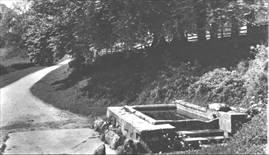
Spring on Well Lane
In 1476, Edward IV gave a charter to the town authorising two fairs, the first on
the 12 May, the other on the 24 October. Over 500 years later these dates are still
used to fix the two horse fairs held each year. The town's main source of wealth
at that time was wool, and sheep from the surrounding hills and villages were brought
to the fairs in the Square where it is said that as many as twenty thousand sheep
were sold on a good day. The narrow alleyways called 'tures' leading from the Square
to the perimeter of the town were constructed for the better control of animals.
The Market Cross was erected as a symbolic reminder to the traders of medieval times
to deal honestly and fairly. The shaft, base and steps are medieval but the gabled
headstone is an addition restored by public subscription in 1995. The side panels
depict the Crucifixion, Edward the Confessor, the Civil War and the Wool Trade. The
gipsy horse fair is, by tradition, held on the nearest Thursday to the two Charter
days.
St. Edward's Hall stands in the Square, built in 1878 from unclaimed deposits placed
in the Town Saving Bank. As well as providing the town with a meeting place, it also
houses the library. A figure of St. Edward stands in a niche over the main entrance.
The steeple, called a bell-turret, was constructed to accommodate a bell used to
summon the fire brigade.
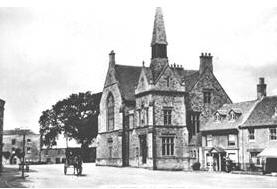
St. Edward’s Hall
The Parish Church of St. Edward was built between the 11th and the 15th century.
The tower was the last part of the church to be completed in 1447. It is 88' high
and houses the heaviest peal of eight bells in Gloucestershire; it is also very prominent
for miles around. The painting of the Crucifixion in the south aisle was painted
by Gaspar de Craeyer (1582 - 1669), a contemporary of Rubens and Van Dyck. Many features
of this outstanding Cotswold Church may be attributed to the town's prosperity as
a centre of the Wool Trade.
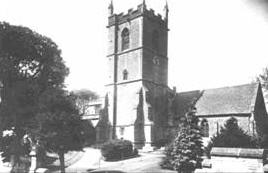
St Edwards Parish Church
Today Stow-on-the-Wold draws people from all over the world. It used to be that
the winter months were very quiet, but during my time at the Visitor Information
Centre, we noticed increasing numbers coming no matter what the season. People come
just to walk about the square, the narrow lanes and the tures, to visit the many
antique shops, to take afternoon tea in one of the old teashops and get a feel for
the ambience of this lovely old town. Put simply, it is a nice place to visit.
For more information about visiting Stow-on-the-Wold. |






